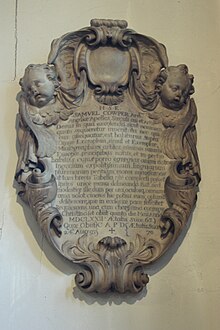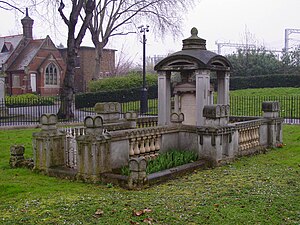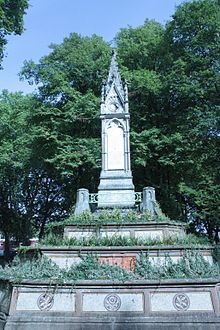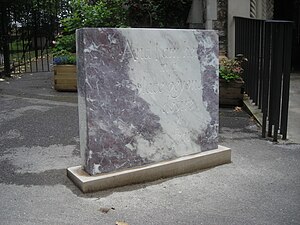St Pancras Old Church
| St Pancras Old Church | |
|---|---|
 St Pancras Old Church | |
 | |
| Denomination | Church of England |
| Tradition | Anglo-Catholic |
| Website | posp.co.uk/st-pancras-old-church |
| Administration | |
| Province | Canterbury |
| Diocese | London |
| Episcopal area | Edmonton |
| Archdeaconry | Hampstead |
| Deanery | South Camden |
| Parish | Old St Pancras |
| Clergy | |
| Bishop(s) | The Rt RevdJonathan Baker(AEO) |
| Vicar(s) | James Elston |
Listed Building– Grade II* | |
| Official name | Old Church of St Pancras |
| Designated | 10 June 1954 |
| Reference no. | 1066500[1] |
St Pancras Old Churchis aChurch of England parish churchon Pancras Road,Somers Town,in theLondon Borough of Camden.Somers Town is an area of the ancient parish and later Metropolitan Borough ofSt Pancras.
Dedicated to the Roman martyrSaint Pancras,the patron saint of children, it is reputed to be one of theoldest sites of Christian worship in England,but this is not supported by strong evidence. St Pancras Old Church, which was largely rebuilt in theVictorian era,should not be confused withSt Pancras New Church(1819–1822) about 860 metres (940 yd) away onEuston Road.
History
[edit]The building served the large ancient parish ofSt Pancras,which stretched from a point a short distance north ofOxford Street,northward toHighgate.

Origins
[edit]By some traditions, the church has been a site of Christian worship since AD 314, but as with most parish churches, especially the older ones, there is little documentary or archaeological evidence to allow the first use of the site to be dated.[2]Remnants ofmedievalfeatures in the building and references in theDomesday Booksuggest the site was in use during the Anglo-Saxon period.[3]
As early as 1593 the cartographerJohn Nordenhad commented in hisSpeculum Britanniaethat the dilapidated St Pancras church looked older thanSt Paul's Cathedral.[4]By the 18th century there seems to have been a local belief that St Pancras was of very great age, perhaps the oldest church in England.
Roman tradition
[edit]Information panels outside the church today state that it "stands on one of Europe’s most ancient sites of Christian worship, possibly dating back to the early 4th century" and has been a "site of prayer and meditation since 314 AD". A vicar of the church claimed (at some point prior to 1870) to have seen a document in theVatican Librarythat placed the foundation to the 4th century, during the Roman period.[5][6]
The case for a Roman period establishment was argued by local historian Charles Lee in 1955, who wrote:
There can be little doubt that a Roman encampment was situated opposite the site of St Pancras Church about this period, and that the church is on the site of a Roman Compitum, which served as a centre of public worship and public meeting... It seems probable that the Roman Compitum at St Pancras was adapted to Christian worship shortly after the restoration of religious freedom in 313 (taking its name from the recently-martyred Pancras).[7]
Lee's "Roman encampment" was "Caesar’s Camp at Pancras called the Brill", identified by the antiquaryWilliam Stukeleyin the 1750s.[8][9]However, some at least of Stukeley's contemporaries could see no trace of this camp, and considered that Stukeley had let his imagination run away with him.[10]
Gillian Tindallhas suggested that the lumps and bumps in the fields to the west of the church that Stukeley interpreted as a Roman camp were actually traces of the original medieval village of St Pancras, before the centre of the settlement moved north to the area now known as Kentish Town.[11]
Lee's use of the wordcompitum,properly a Roman temple or shrine situated at a crossroads, indicates his indebtedness to the work ofMontagu Sharpe(1856–1942), aMiddlesexmagistrate, former chairman of theMiddlesex County Counciland amateur historian and archaeologist.[12]Sharpe had proposed, in a book first published in 1919, that the area of the county of Middlesex had in Roman times been subject to the form of land division known ascenturiation,marked out by roads in a regular grid pattern covering the whole county.[13]Sharpe noted, when plotting his gridlines, that a number of ancient parish churches appeared to be on or close to intersections, or at least on road alignments. He concluded that these churches must therefore stand on the sites of pagancompita,and represent the deliberate conversion of pagan temples to Christian use by early missionaries to theMiddle Saxonsin the 7th century. St Pancras Old Church is one of those marked on Sharpe's map.
Anglo-Saxon period
[edit]In 597,Pope Gregory the GreatsentAugustine of Canterburyat the head of a group of 40 monks intending to promote the re-establishment of Christianity in England. Pope Gregory sent Augustine with relics of St Pancras, and the first church Augustine established, was dedicated to St Pancras and located inCanterbury,the capital of theKingdom of Kent.Some traditions also ascribe the establishment of the St Pancras Old Church, or its dedication to St Pancras, with Augustine's mission and the relics he brought.
J. Carter Rendell (vicar 1912–26) argued that a medieval altar slab marked with fiveconsecration crosses,found during the 19th-century building works, could be dated to the 6th century.[5][6]
Phil Emery and Pat Miller discuss the archaeological history of the site in 'Archaeological findings at the site of the St Pancras Burial Ground and its vicinity':
The 1847 reconstruction of the medieval church revealed Roman tiles in the fabric of its tower and an inscribed altar stone dated to AD 625 (other sources estimate an AD 600 date[14]), which might suggest an early 7th-century foundation. The original cemetery around the church appears to have been sub-circular like many late Saxon cemeteries
These archaeological findings seem to go some way to countering the 18th century London historianWilliam Maitland,who dismissed links to Augustine's era as a "vulgar Tradition", and suggested that there was confusion with the ancient church with the same dedication in the grounds ofSt Augustine's AbbeyinCanterbury,which was said to have been converted from a pagan temple by Augustine in 598.[15]
In 1870 local historian Samuel Palmer reported "This old and venerable church is said to be the first Christian place of worship in the county of Middlesex in the eighth or ninth century."[16]
An earlier vicar is said to have claimed to have seen in theVatican Librarya manuscript mentioning that St Pancras church was built in the 9th century (in addition to the other clergyman who claimed to have found reference to a Roman era establishment).[5][6]
Medieval and Tudor church building
[edit]

When the church was rebuilt in 1847, builders found some evidence of Anglo-Saxon period church activity and some re-used Roman tiles in the walls. They were able to identify that the church building they were replacing was mainly late Tudor with elements of earlier structures incorporated.
According to a Victorian architect,Robert Lewis Roumieu,involved in the works:
The old church was principally late Tudor. When it was pulled down to be rebuilt, several small Norman columns, pilaster piers and other remains of a Norman edifice were found among the materials used in the wall, leaving no doubt but that the original church had been a Norman structure which had been at some time completely rebuilt and part used as building material in the reconstruction.[17]
In the early Middle Ages there was a centre of population in the vicinity of what is now known as the old church. However, in the 14th century the focus of population is thought to have shifted to what is nowKentish Town(further north in St Pancras parish). The reasons for this were probably the vulnerability of the plain around the church to flooding (theRiver Fleet,which is now underground, runs through it) and the availability of better wells at Kentish Town, where there is less clay in the soil.
Richard Granger is named as parson of the church of St Pancras, in 1446.[18]
Disrepair and restoration
[edit]Afterthe Reformationthe isolation and decay of the church made ita tempting resort for Catholics:indeed, it was said that the last bell which tolled for the Mass in England was at St Pancras.[19]St Pancras (and to a lesser degreePaddington Church) were the only places in London where Roman Catholics were permitted to be buried.[20]Among the several Catholics buried in the churchyard wasJohann Christian Bach,youngest son ofJohann Sebastian Bach.[19]His name was misspelled in the burial register as John Cristian Back.[21]
The church fell into disrepair and towards the end of the 18th century services were only held there on one Sunday each month; on other weeks, the same congregation would use a chapel in Kentish Town.[22]18th and early 19th century urban expansion led to the construction of the capaciousSt Pancras New Churchon what was then the "New Road" (Euston Road,about a km away).[a]The old building lost its status as theparish churchwhen the New Church was consecrated in 1822, and became achapel of ease.As it stood in the early 19th century, the church consisted of an unaislednave,achancelwithout achancel archand a western tower. The south porch had served as avestrysince the 18th century.


By 1847 the Old Church was derelict, but in view of the growth of population in the southern part of the parish, it was decided to restore it. (Victorian restorationof churches is not what we understand today by the phrasebuilding restoration.) The architect of the alterations wasAlexander Dick Gough.The old tower was removed, allowing the nave to be extended westwards, and a new tower was built on the south side. The south porch was removed, and a new vestry was added on the north side. The whole exterior of the church was refaced or reworked.[3]The enlargement and the addition of galleries increased the capacity of the church from about 120 to 500.[24]
There were further restorations in 1888 byArthur Blomfieldwith the reredos byC E Buckeridge;in 1925 when the plaster ceiling and the side galleries were removed,[3]and in 1948 followingSecond World War bomb damage.The building was designated a grade II*listed buildingon 10 June 1954,[25][26]That year also saw the former parish of Christ Church Somers Town (destroyed in the 1940 Blitz) merged into that of St Pancras Old Church,[27][28]followed by that of St Matthew's Oakley Square in 1956.[29]
Present organisation
[edit]The church has achaplaincyto the nearbySt Pancras Hospitaland from 2003 to 2023 it formed part of the Old St Pancras Parish (which also includedSt Michael's Church, Camden Town,St Mary's Church, Somers TownandSt Paul's Church, Camden Square- all four are now independent parishes again).[30]On 11 December 2007 it marked the opening of the nearbySt Pancras Internationalstation with a bilingual service and a twinning with theChurch of Saint-Vincent-de-Paul, Paris,near theGare du Nord,Paris.[31]In 2013 an official appeals project was launched to raise the funds necessary to preserve the church and grounds.[32]
As a traditional Anglo-Catholic church that rejects the ordination of women as priests and bishops, it receivesalternative episcopal oversightfrom theBishop of Fulham(currentlyJonathan Baker).[33]
Internal monuments
[edit]
The church contains the grave ofSamuel Cooper(or Cowper), the miniaturist, against its east wall.
Churchyard
[edit]
The churchyard, which is the largest green space in the locality, is managed by theLondon Borough of Camden.It has some fine mature trees, and was restored in the first few years of the 21st century.
The graveyard served not only as a burial place for the parishioners but also for Roman Catholics from all around London.[34]They included manyFrench refugees(émigrés), especially priests, who had fled theRevolution,one of them the spyChevalier d'Éon.[35]Notable people buried in the churchyard include the notorious colonial administratorJoseph Wallwho was executed for cruelty in 1802. The famous vampire writer ("The Vampyre"published in 1819) and physicianJohn William Polidori(buried in 1821), the composersCarl Friedrich AbelandJohann Christian Bach,the eighteenth child ofJohann Sebastian Bach,and the sculptorJohn Flaxman.William Franklin,the illegitimate son ofBenjamin Franklinand last colonialGovernor of New Jersey,was interred here in 1814. There is a spousal memorial tomb for philosophers and writersMary WollstonecraftandWilliam Godwin,though their remains are now inBournemouth.In 2009, commemorations of the 250th anniversary of Wollstonecraft's birth were held by various groups, both inside the church[36]and at the gravestone.[37]In the 17th and 18th centuries, many foreign dignitaries and aristocrats were buried in the graveyard; they are commemorated on theBurdett-Coutts Memorial Sundial,an elaborate memorial commissioned by the philanthropistAngela Burdett-Coutts, 1st Baroness Burdett-Coutts.
The architectJohn Soanedesigned a tomb for his wife and himself in the churchyard, which is nowGrade I listed.This mausoleum may have provided the inspiration for the design byGiles Gilbert Scottof the iconicred telephone boxes.



Other people associated with the churchyard include the poetPercy Bysshe Shelleyand the futureMary Shelley,who planned their 1814 elopement over meetings at the grave of her mother, Mary Wollstonecraft, mentioned above.Charles Dickensmentions it by name in his 1859 novelA Tale of Two Cities,making it the location ofbody snatchingto provide corpses for dissection at medical schools, a common practice at the time. Burials in the churchyardeventually ceasedunder the Extramural Interment Act in 1854, andSt Pancras and Islington Cemeterywas opened in East Finchley.[39]In the mid-1860s, the youngThomas Hardywas in charge of the excavation of part of the graveyard in the course of the construction of theMidland Railway's London terminus,St Pancras station.[40]More burials were removed in 2002.

The churchyard was reopened in June 1877 as St Pancras Gardens, following the movement to allow conversion of disused burial grounds into public gardens.Angela Burdett-Coutts,an important local benefactress, laid the foundation stone of thememorial sundialshe had presented.[41]
A recent addition is a polished marble stone at the entrance to the church, a collaboration between and a gift from the poetJeremy Clarkeand the sculptorEmily Young.It is inscribed: "And I am here / in a place / beyond desire or fear", an extract from the long poem "Praise" by Clarke.
Names of note listed on the Burdett Coutts Memorial as lost
[edit]This impressive monument was erected in 1877 when the northern half of the churchyard was formalised as a public park, clearing most of the smaller gravestones. It lists stones lost to this and earlier clearances for the railways.
- William Brett (d.1828), artist and engraver
- Henry Burdett, goldsmith (d.1736) and ancestor ofAngela Burdett-Coutts, 1st Baroness Burdett-Coutts(the probable inspiration for the monument)
- Mary Burke, wife ofJohn Burke (genealogist),author of Burke's Peerage
- Tiberius Cavallo,physicist and philosopher
- John Danby,musician
- Arthur Richard Dillon,French archbishop (later re-interred in France)
- Rufane Shaw Donkin,military hero who committed suicide
- Chevalier d'Eon,spy and fencer
- John Flaxman,sculptor
- John Fleetwood,baronet
- Bonaventure Giffardand his father Andrew Giffard
- John Ernest Grabe,theologian
- John Gurney,judge; this grave is intact and legible but the inscription faces the boundary
- Louis Charles d'Hervilly
- Giacomo Leoni,architect
- Maurice Margarot,reformer
- Thomas Mazzinghi, father ofJoseph Mazzinghi
- Arthur O'Leary,Franciscan preacher
- Pasquale Paoli,Corsican hero (later re-interred in Corsica)
- Stephen Paxton,musician
- Simon François Ravenet,engraver
- Mary Slingsby,actress
- Charles Henry Talbot,baronet
- Henry Tempest(d.1753)
- John Walker,lexicographer; this monument still survives and was independently restored by Angela Burdett-Coutts
Other known burials
[edit]SeeLysons 2016
- Carl Friedrich Abel,composer
- Johann Christian Bach,composer
- Peter van Bleeck,artist
- Francis Blyth,Carmelite friar and Roman Catholic priest
- Edward Boteler(d.1681), MP for Poole
- George Chalmers,artist
- Jeremy Collier,bishop
- Timothy Cunningham(d.1789), founder of theRoyal Irish Academy'sCunningham Medal
- Charles Dillon, 10th Viscount Dillon(d.1741) and Lady Dillon (d.1751) and other family members
- Thomas Dongan, 2nd Earl of Limerick
- William Franklin,son ofBenjamin Franklin
- Bevil Higgons,historian
- Antoinette-Cecile de Saint-Huberty, opera singer
- Abraham Langford,auctioneer and playwright
- Thomas Mackworth(d.1744), baronet
- Joseph Richards(d.1738), baronet
- Thomas Scheemakers(1740–1808), sculptor[42]
- Giovanna Sestini(1749–1814), opera singer
- Giambattista Tocco, Duke de Sicignano(c.1760–1793), ambassador from the Kingdom of Naples to Great Britain, committed suicide shortly after his arrival in London in 1793.[43]
- Henry Sidgier,holder of a 1782 patent on a design for a washing machine[44]
- Duncan Stewart of Ardsheal,clan chief
- Benjamin Turney(1755–1836), doctor trained at St Thomas. Lived for some years in Jamaica on Golden Grove Sugar Plantation.
- Joseph Wall,governor of Coree in West Africa, hanged for flogging a soldier to death
- Ned Ward,publican and comic author (no memorial)
- Samuel Webbe,composer (monument and inscription survives but its upper obelisk is missing)
- Jonathan Wild,criminal
- John Wittewrong(d.1743), baronet
- Abraham Woodhead,academic
- William Woollett,engraver (no monument, despite not being listed on the Burdett Coutts memorial as an important grave lost). Woollett certainly was important as he was nationally recognised by a memorial inWestminster Abbey.
Popular culture
[edit]On 6 July 1811, the composer and pianist Muzio Clementi married Emma Gisborne.
On 28 July 1968,The Beatleswere photographed in the churchyard grounds, in a famous series of pictures designed to promote the single "Hey Jude"and theWhite Album.[45]A memorial bench bears a plaque commemorating the group's "Mad Day Out".[46]
The video forLene Lovich's 1979 hit "Bird Song" was filmed in the church and churchyard.[47]
In 2013, British R&B singerSam Smithperformed two concerts at the church. The live version of "I've Told You Now" was included on deluxe editions of their albumIn the Lonely Hour.[48]
On 24 September 2014, singerClaudia Brücken,best known for her work with German electronic groupPropaganda,performed a solo show at the church.[49]
St Pancras Old Church is frequently mentioned in the Bryant and May detective series by authorChristopher Fowler.
References
[edit]- ^Historic England."Old Church of St Pancras (1113246)".National Heritage List for England.Retrieved10 November2016.
- ^Inglis 2007,p. 26.
- ^abcLovell, Percy; Marcham, William McB., eds. (1938). "St. Pancras Old Church".Survey of London.Vol. 19: The parish of St Pancras part 2: Old St Pancras and Kentish Town. pp. 72–95.Retrieved26 May2010.
- ^Norden, John(1593).Speculum Britanniae: the First Parte: an Historicall, & Chorographicall Description of Middlesex.[London]. p. 38.
- ^abcLee 1955.
- ^abcDenyer, C. H. (1935).St Pancras through the Centuries.London: Le Play House Press. p. 13.
- ^Lee 1955,pp. 7–10.
- ^Stukeley, William(1776).Itinerarium Curiosum.Vol. 2. London: Baker & Leigh. pp. 1–16.
- ^Stukeley's original plan of Caesar's Camp in the British Library"Caesar's Camp at Pancras".Retrieved4 April2013.
- ^Lysons 2016,pp. 343–44.
- ^Tindall, Gillian(2010).The Fields Beneath: The History of One London Village(new ed.). London: Eland. pp. 41–42.ISBN978-1-906011-48-2.
- ^Willment, Diana (2007).Sir Montagu Sharpe: Forgotten Man of Middlesex.Brentford: Dandelion.ISBN978-0-954-05904-0.
- ^Sharpe, Montagu (1919).Middlesex in British, Roman and Saxon Times.London: G. Bell & Sons. pp.62–77.
- ^London Encyclopaedia, Weinreb and Hibbert, 1983
- ^Maitland, William(1739).The History of London from its Foundation by the Romans, to the Present Time.London: Samuel Richardson. p. 781.
- ^Palmer 1870,p. 23.
- ^"St Pancras Old Church".Building News:137. 1871.
- ^appears as defendant in the 8th entry inhttp://aalt.law.uh.edu/AALT1/H6/CP40no740/bCP40no740dorses/IMG_1604.htm
- ^ab"The 14-year-old beheaded for his faith whose name lives on in north London".Catholic Herald.12 May 2013.
- ^Lysons 2016,p. 346.
- ^Broughton, Mrs Vernon Delves, ed. (1887)."Court and Private Life in the Time of Queen Charlotte".pp. 151–153.
- ^Lysons 2016,p. 365.
- ^Palmer 1870,p. 32.
- ^Cansick 1869,pp. xiii–xiv.
- ^Historic England."Details from listed building database (1113246)".National Heritage List for England.Retrieved22 January2009.
- ^Historic England."Old Church of St Pancras (1113246)".National Heritage List for England.Retrieved3 April2015.
- ^"London Metropolitan Archive - CHRIST CHURCH, SOMERS TOWN: CHALTON STREET, CAMDEN".
- ^"Christ Church Somers Town".
- ^"SAINT MATTHEW, SAINT PANCRAS: OAKLEY SQUARE, CAMDEN".
- ^"Parish of Old St Pancras".Retrieved4 April2013.
- ^"Parishes forge entente cordiale".Camden New Journal.13 December 2007.
- ^"Our challenge".St Pancras Old Church Appeals.Archived fromthe originalon 6 September 2014.Retrieved6 September2014.
Ancient drains that lie beneath the church are collapsing. As a result they are destabilising the structure of the church.
- ^"Old St Pancras".Bishop of Fulham.Retrieved14 July2020.
- ^Palmer 1870,p. 27.
- ^Emery, Phil."End of the line".British Archaeology. Archived fromthe originalon 25 July 2014.Retrieved29 September2013.
- ^"Tributes to feminist Mary, 250 years on".Camden New Journal.30 April 2009.
- ^Gruner, Peter (17 April 2009)."Festival for first feminist".Islington Tribune.
- ^"The Hardy Tree Of St Pancras Has Fallen".Londonist.28 December 2022.Retrieved28 December2022.
- ^"Family Grows on Trees research into St Pancras area".Family Grows on Trees.
- ^Burley, Peter (2012). "When steam railroaded history".Cornerstone.33(1): 9.
- ^"St Pancras Gardens".London Gardens Online.Retrieved26 August2012.
- ^Matthew, H. C. G.; Harrison, Brian, eds. (2004).Oxford Dictionary of National Biography: Scheemakers.Oxford University Press.ISBN978-0-19-861411-1.
- ^Lysons, Daniel (1811).The Environs of London: Middlesex.T. Cadell and W. Davies. p. 634.
- ^Long, Heather."Who invented the washing machine and dryer".Love to Know.Retrieved19 December2016.
- ^Shea, Stuart; Rodriguez, Robert (2007).Fab Four FAQ: Everything Left to Know About the Beatles... and More!.New York: Hal Leonard Corporation. p. 114.ISBN9781458462596.Retrieved1 March2016.
- ^"London's Famous Bench Dedications".Londonist.21 October 2016.Archivedfrom the original on 6 March 2018.Retrieved12 October2018.
- ^Balls, Richard (2013).Be Stiff: The Stiff Records Story.London: Soundcheck Books. p. 200.ISBN9780957570061.Retrieved1 March2016.
- ^Allan, Joe (2015).Sam Smith – The Biography.London: John Blake Publishing. p. 113.ISBN9781784188610.Retrieved1 March2016.
- ^"Claudia Brücken".dsomedia.24 September 2014.Retrieved1 March2016.
Sources
[edit]- Cansick, Frederick Teague (1869).A Collection of Curious and Interesting Epitaphs Copied from the Monuments of Noted Characters in the Ancient Church and Burial Grounds of Saint Pancras, Middlesex.London: J. Russell Smith.
- Inglis, Angela (2007).Railway Lands: Catching St. Pancras and King's Cross.Troubador.ISBN978-1-906221-40-9.
- Lee, Charles Edward (1955).St. Pancras Church and Parish.St. Pancras Parochial Church Council.
- Lysons, Daniel (2016) [1795].The Environs of London.Vol. 3: Being an Historical Account of the Towns, Villages, and Hamlets, Within Twelve Miles of That Capital, Interspersed With Biographical Anecdotes, County of Middlesex. Fb&c Limited.ISBN978-1-333-76731-0.
- Palmer, Samuel (1870).St Pancras; Being Antiquarian Topographical and Biographical Memoranda Relating to the Extensive Metropolitan Parish of St Pancras.London: Samuel Palmer; Field and Tuer.
Further reading
[edit]- 'Richardson, John (1991).Camden Town and Primrose Hill Past: A Visual History of Camden Town and Primrose Hill.Historical Publications.ISBN978-0-948667-12-1.
- Baal, Iphgenia (2011).The Hardy Tree: A Story about Gang Mentality.Trolley.ISBN978-1-907112-29-4.
